NUR250 S1 2018 Assessment 1: Patient Assessment and Care Planning
VerifiedAdded on 2021/04/21
|18
|3584
|27
Homework Assignment
AI Summary
This assignment presents a comprehensive patient assessment and care plan for a patient, Jim, diagnosed with Influenza. The assessment focuses on identifying key nursing problems, including ineffective airway clearance, ineffective breathing pattern, hyperthermia, self-care deficit, risk of infection, and risk of imbalanced fluid volume. The care plan includes detailed nursing interventions, rationales, and expected outcomes for each identified problem, such as isolating the patient to prevent infection spread and encouraging self-care activities. The assignment also covers medication management, including the use of oseltamivir, paracetamol, and Fluvax IM, with considerations for dosage, side effects, and patient monitoring. Patient teaching is addressed, particularly focusing on the health implications of smoking and hypertension. The importance of patient education, including smoking cessation strategies, is emphasized to improve patient outcomes and prevent complications associated with influenza and related health issues. The assignment uses a problem-based approach, integrating evidence-based practices to ensure effective patient care.
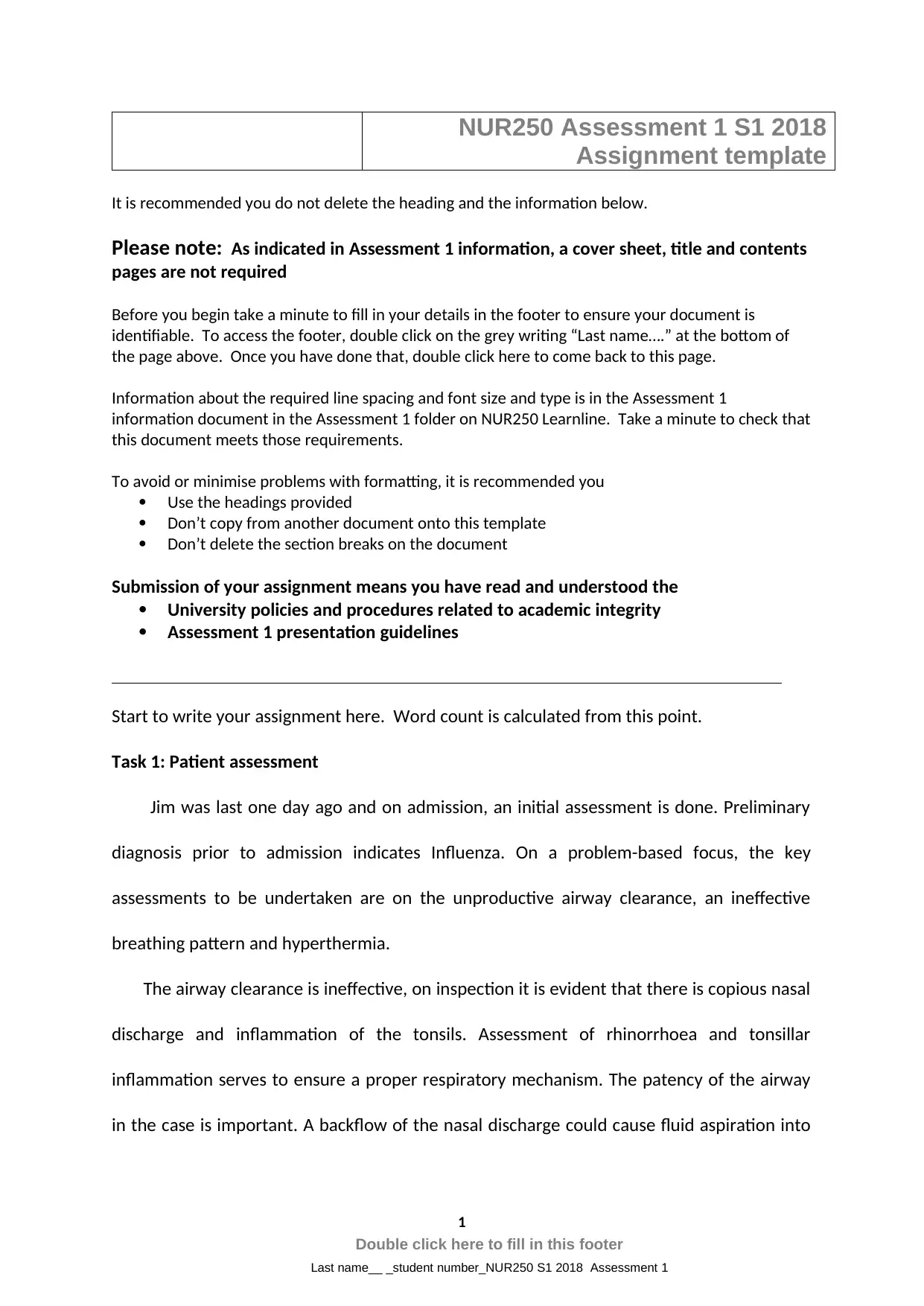
NUR250 Assessment 1 S1 2018
Assignment template
It is recommended you do not delete the heading and the information below.
Please note: As indicated in Assessment 1 information, a cover sheet, title and contents
pages are not required
Before you begin take a minute to fill in your details in the footer to ensure your document is
identifiable. To access the footer, double click on the grey writing “Last name….” at the bottom of
the page above. Once you have done that, double click here to come back to this page.
Information about the required line spacing and font size and type is in the Assessment 1
information document in the Assessment 1 folder on NUR250 Learnline. Take a minute to check that
this document meets those requirements.
To avoid or minimise problems with formatting, it is recommended you
Use the headings provided
Don’t copy from another document onto this template
Don’t delete the section breaks on the document
Submission of your assignment means you have read and understood the
University policies and procedures related to academic integrity
Assessment 1 presentation guidelines
Start to write your assignment here. Word count is calculated from this point.
Task 1: Patient assessment
Jim was last one day ago and on admission, an initial assessment is done. Preliminary
diagnosis prior to admission indicates Influenza. On a problem-based focus, the key
assessments to be undertaken are on the unproductive airway clearance, an ineffective
breathing pattern and hyperthermia.
The airway clearance is ineffective, on inspection it is evident that there is copious nasal
discharge and inflammation of the tonsils. Assessment of rhinorrhoea and tonsillar
inflammation serves to ensure a proper respiratory mechanism. The patency of the airway
in the case is important. A backflow of the nasal discharge could cause fluid aspiration into
1
Double click here to fill in this footer
Last name__ _student number_NUR250 S1 2018 Assessment 1
Assignment template
It is recommended you do not delete the heading and the information below.
Please note: As indicated in Assessment 1 information, a cover sheet, title and contents
pages are not required
Before you begin take a minute to fill in your details in the footer to ensure your document is
identifiable. To access the footer, double click on the grey writing “Last name….” at the bottom of
the page above. Once you have done that, double click here to come back to this page.
Information about the required line spacing and font size and type is in the Assessment 1
information document in the Assessment 1 folder on NUR250 Learnline. Take a minute to check that
this document meets those requirements.
To avoid or minimise problems with formatting, it is recommended you
Use the headings provided
Don’t copy from another document onto this template
Don’t delete the section breaks on the document
Submission of your assignment means you have read and understood the
University policies and procedures related to academic integrity
Assessment 1 presentation guidelines
Start to write your assignment here. Word count is calculated from this point.
Task 1: Patient assessment
Jim was last one day ago and on admission, an initial assessment is done. Preliminary
diagnosis prior to admission indicates Influenza. On a problem-based focus, the key
assessments to be undertaken are on the unproductive airway clearance, an ineffective
breathing pattern and hyperthermia.
The airway clearance is ineffective, on inspection it is evident that there is copious nasal
discharge and inflammation of the tonsils. Assessment of rhinorrhoea and tonsillar
inflammation serves to ensure a proper respiratory mechanism. The patency of the airway
in the case is important. A backflow of the nasal discharge could cause fluid aspiration into
1
Double click here to fill in this footer
Last name__ _student number_NUR250 S1 2018 Assessment 1
Paraphrase This Document
Need a fresh take? Get an instant paraphrase of this document with our AI Paraphraser
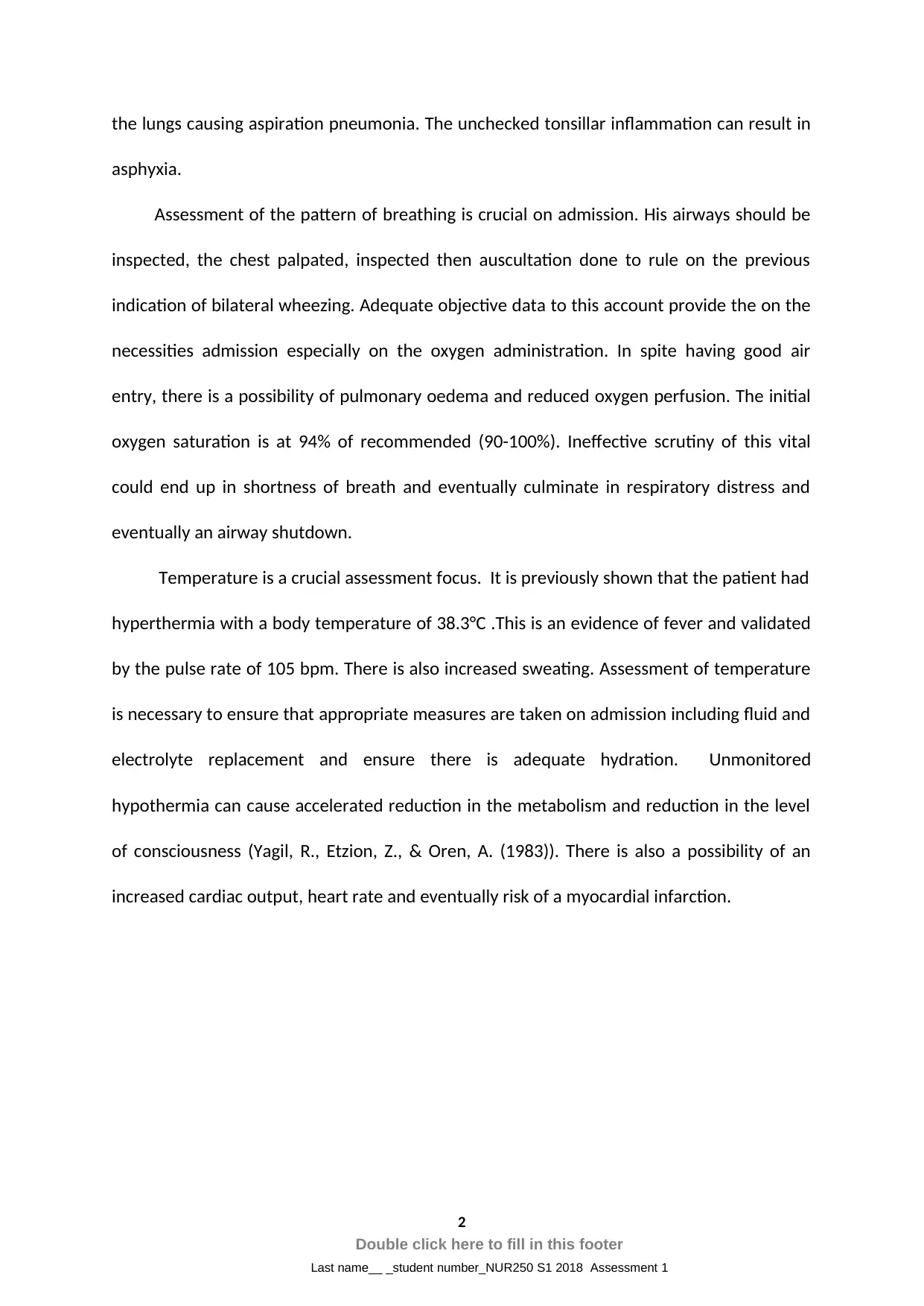
the lungs causing aspiration pneumonia. The unchecked tonsillar inflammation can result in
asphyxia.
Assessment of the pattern of breathing is crucial on admission. His airways should be
inspected, the chest palpated, inspected then auscultation done to rule on the previous
indication of bilateral wheezing. Adequate objective data to this account provide the on the
necessities admission especially on the oxygen administration. In spite having good air
entry, there is a possibility of pulmonary oedema and reduced oxygen perfusion. The initial
oxygen saturation is at 94% of recommended (90-100%). Ineffective scrutiny of this vital
could end up in shortness of breath and eventually culminate in respiratory distress and
eventually an airway shutdown.
Temperature is a crucial assessment focus. It is previously shown that the patient had
hyperthermia with a body temperature of 38.3°C .This is an evidence of fever and validated
by the pulse rate of 105 bpm. There is also increased sweating. Assessment of temperature
is necessary to ensure that appropriate measures are taken on admission including fluid and
electrolyte replacement and ensure there is adequate hydration. Unmonitored
hypothermia can cause accelerated reduction in the metabolism and reduction in the level
of consciousness (Yagil, R., Etzion, Z., & Oren, A. (1983)). There is also a possibility of an
increased cardiac output, heart rate and eventually risk of a myocardial infarction.
2
Double click here to fill in this footer
Last name__ _student number_NUR250 S1 2018 Assessment 1
asphyxia.
Assessment of the pattern of breathing is crucial on admission. His airways should be
inspected, the chest palpated, inspected then auscultation done to rule on the previous
indication of bilateral wheezing. Adequate objective data to this account provide the on the
necessities admission especially on the oxygen administration. In spite having good air
entry, there is a possibility of pulmonary oedema and reduced oxygen perfusion. The initial
oxygen saturation is at 94% of recommended (90-100%). Ineffective scrutiny of this vital
could end up in shortness of breath and eventually culminate in respiratory distress and
eventually an airway shutdown.
Temperature is a crucial assessment focus. It is previously shown that the patient had
hyperthermia with a body temperature of 38.3°C .This is an evidence of fever and validated
by the pulse rate of 105 bpm. There is also increased sweating. Assessment of temperature
is necessary to ensure that appropriate measures are taken on admission including fluid and
electrolyte replacement and ensure there is adequate hydration. Unmonitored
hypothermia can cause accelerated reduction in the metabolism and reduction in the level
of consciousness (Yagil, R., Etzion, Z., & Oren, A. (1983)). There is also a possibility of an
increased cardiac output, heart rate and eventually risk of a myocardial infarction.
2
Double click here to fill in this footer
Last name__ _student number_NUR250 S1 2018 Assessment 1

3
Double click here to fill in this footer
Last name__ _student number_NUR250 S1 2018 Assessment 1
Double click here to fill in this footer
Last name__ _student number_NUR250 S1 2018 Assessment 1
⊘ This is a preview!⊘
Do you want full access?
Subscribe today to unlock all pages.

Trusted by 1+ million students worldwide
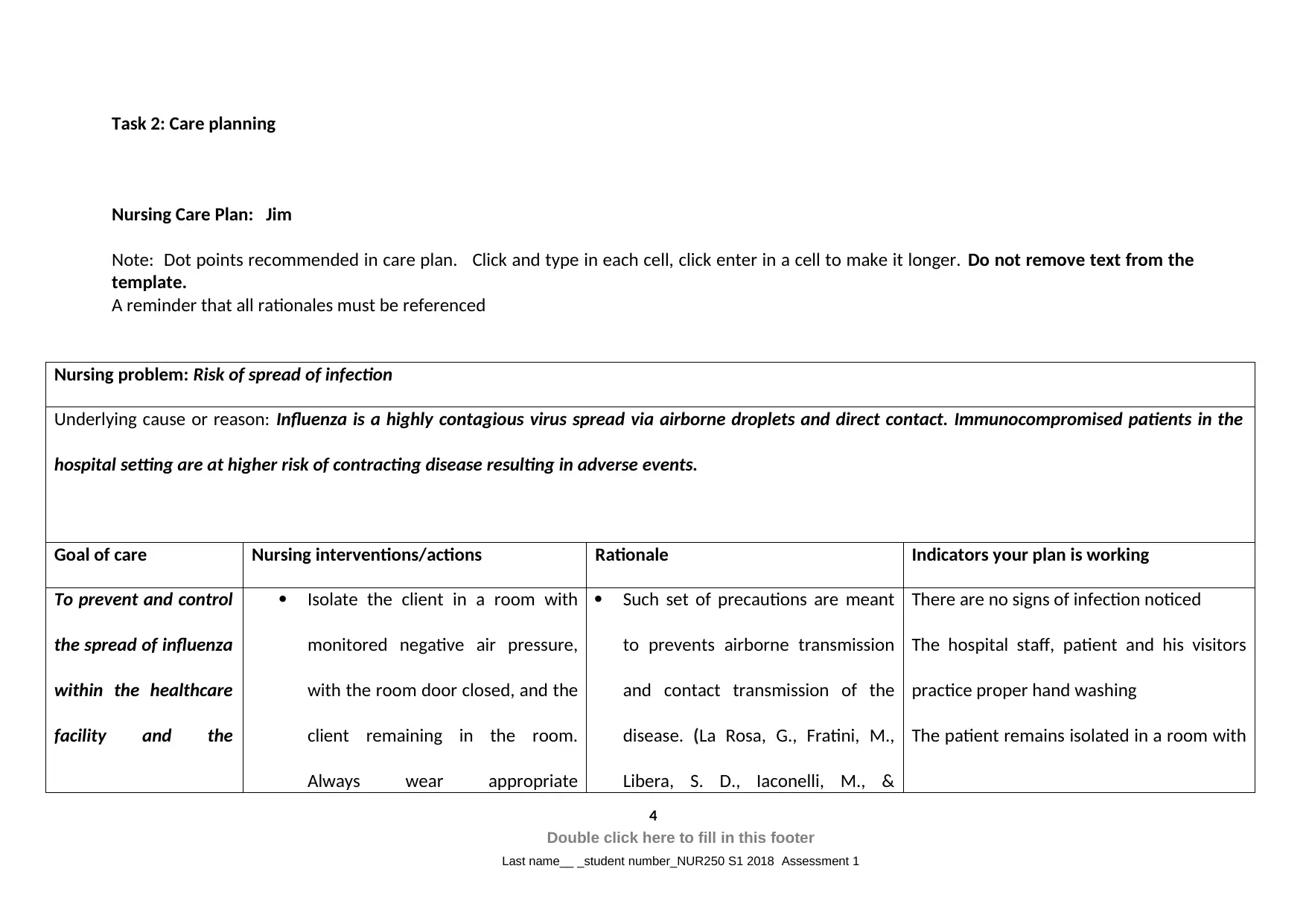
Task 2: Care planning
Nursing Care Plan: Jim
Note: Dot points recommended in care plan. Click and type in each cell, click enter in a cell to make it longer. Do not remove text from the
template.
A reminder that all rationales must be referenced
Nursing problem: Risk of spread of infection
Underlying cause or reason: Influenza is a highly contagious virus spread via airborne droplets and direct contact. Immunocompromised patients in the
hospital setting are at higher risk of contracting disease resulting in adverse events.
Goal of care Nursing interventions/actions Rationale Indicators your plan is working
To prevent and control
the spread of influenza
within the healthcare
facility and the
Isolate the client in a room with
monitored negative air pressure,
with the room door closed, and the
client remaining in the room.
Always wear appropriate
Such set of precautions are meant
to prevents airborne transmission
and contact transmission of the
disease. (La Rosa, G., Fratini, M.,
Libera, S. D., Iaconelli, M., &
There are no signs of infection noticed
The hospital staff, patient and his visitors
practice proper hand washing
The patient remains isolated in a room with
4
Double click here to fill in this footer
Last name__ _student number_NUR250 S1 2018 Assessment 1
Nursing Care Plan: Jim
Note: Dot points recommended in care plan. Click and type in each cell, click enter in a cell to make it longer. Do not remove text from the
template.
A reminder that all rationales must be referenced
Nursing problem: Risk of spread of infection
Underlying cause or reason: Influenza is a highly contagious virus spread via airborne droplets and direct contact. Immunocompromised patients in the
hospital setting are at higher risk of contracting disease resulting in adverse events.
Goal of care Nursing interventions/actions Rationale Indicators your plan is working
To prevent and control
the spread of influenza
within the healthcare
facility and the
Isolate the client in a room with
monitored negative air pressure,
with the room door closed, and the
client remaining in the room.
Always wear appropriate
Such set of precautions are meant
to prevents airborne transmission
and contact transmission of the
disease. (La Rosa, G., Fratini, M.,
Libera, S. D., Iaconelli, M., &
There are no signs of infection noticed
The hospital staff, patient and his visitors
practice proper hand washing
The patient remains isolated in a room with
4
Double click here to fill in this footer
Last name__ _student number_NUR250 S1 2018 Assessment 1
Paraphrase This Document
Need a fresh take? Get an instant paraphrase of this document with our AI Paraphraser
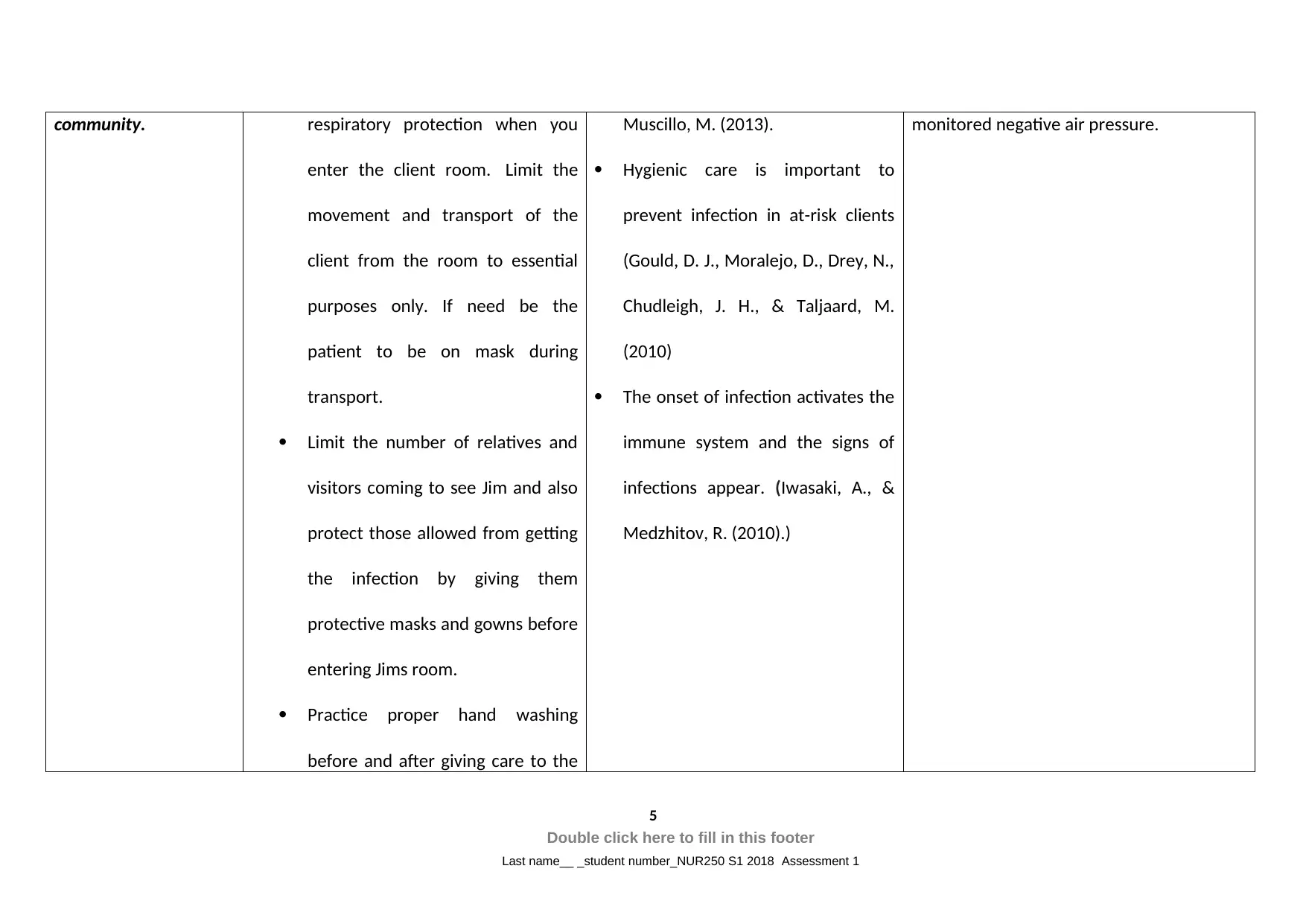
community. respiratory protection when you
enter the client room. Limit the
movement and transport of the
client from the room to essential
purposes only. If need be the
patient to be on mask during
transport.
Limit the number of relatives and
visitors coming to see Jim and also
protect those allowed from getting
the infection by giving them
protective masks and gowns before
entering Jims room.
Practice proper hand washing
before and after giving care to the
Muscillo, M. (2013).
Hygienic care is important to
prevent infection in at-risk clients
(Gould, D. J., Moralejo, D., Drey, N.,
Chudleigh, J. H., & Taljaard, M.
(2010)
The onset of infection activates the
immune system and the signs of
infections appear. (Iwasaki, A., &
Medzhitov, R. (2010).)
monitored negative air pressure.
5
Double click here to fill in this footer
Last name__ _student number_NUR250 S1 2018 Assessment 1
enter the client room. Limit the
movement and transport of the
client from the room to essential
purposes only. If need be the
patient to be on mask during
transport.
Limit the number of relatives and
visitors coming to see Jim and also
protect those allowed from getting
the infection by giving them
protective masks and gowns before
entering Jims room.
Practice proper hand washing
before and after giving care to the
Muscillo, M. (2013).
Hygienic care is important to
prevent infection in at-risk clients
(Gould, D. J., Moralejo, D., Drey, N.,
Chudleigh, J. H., & Taljaard, M.
(2010)
The onset of infection activates the
immune system and the signs of
infections appear. (Iwasaki, A., &
Medzhitov, R. (2010).)
monitored negative air pressure.
5
Double click here to fill in this footer
Last name__ _student number_NUR250 S1 2018 Assessment 1
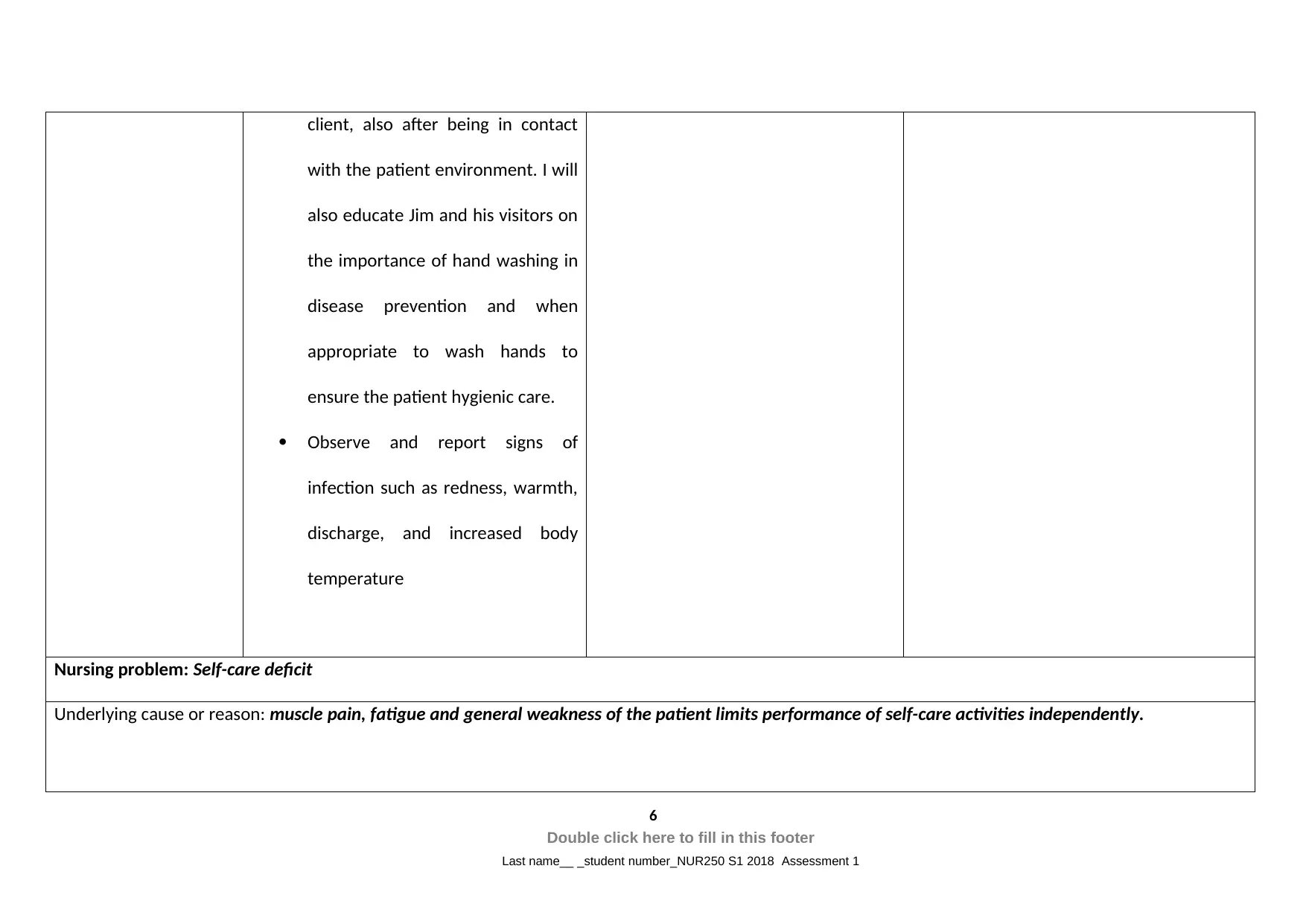
client, also after being in contact
with the patient environment. I will
also educate Jim and his visitors on
the importance of hand washing in
disease prevention and when
appropriate to wash hands to
ensure the patient hygienic care.
Observe and report signs of
infection such as redness, warmth,
discharge, and increased body
temperature
Nursing problem: Self-care deficit
Underlying cause or reason: muscle pain, fatigue and general weakness of the patient limits performance of self-care activities independently.
6
Double click here to fill in this footer
Last name__ _student number_NUR250 S1 2018 Assessment 1
with the patient environment. I will
also educate Jim and his visitors on
the importance of hand washing in
disease prevention and when
appropriate to wash hands to
ensure the patient hygienic care.
Observe and report signs of
infection such as redness, warmth,
discharge, and increased body
temperature
Nursing problem: Self-care deficit
Underlying cause or reason: muscle pain, fatigue and general weakness of the patient limits performance of self-care activities independently.
6
Double click here to fill in this footer
Last name__ _student number_NUR250 S1 2018 Assessment 1
⊘ This is a preview!⊘
Do you want full access?
Subscribe today to unlock all pages.

Trusted by 1+ million students worldwide
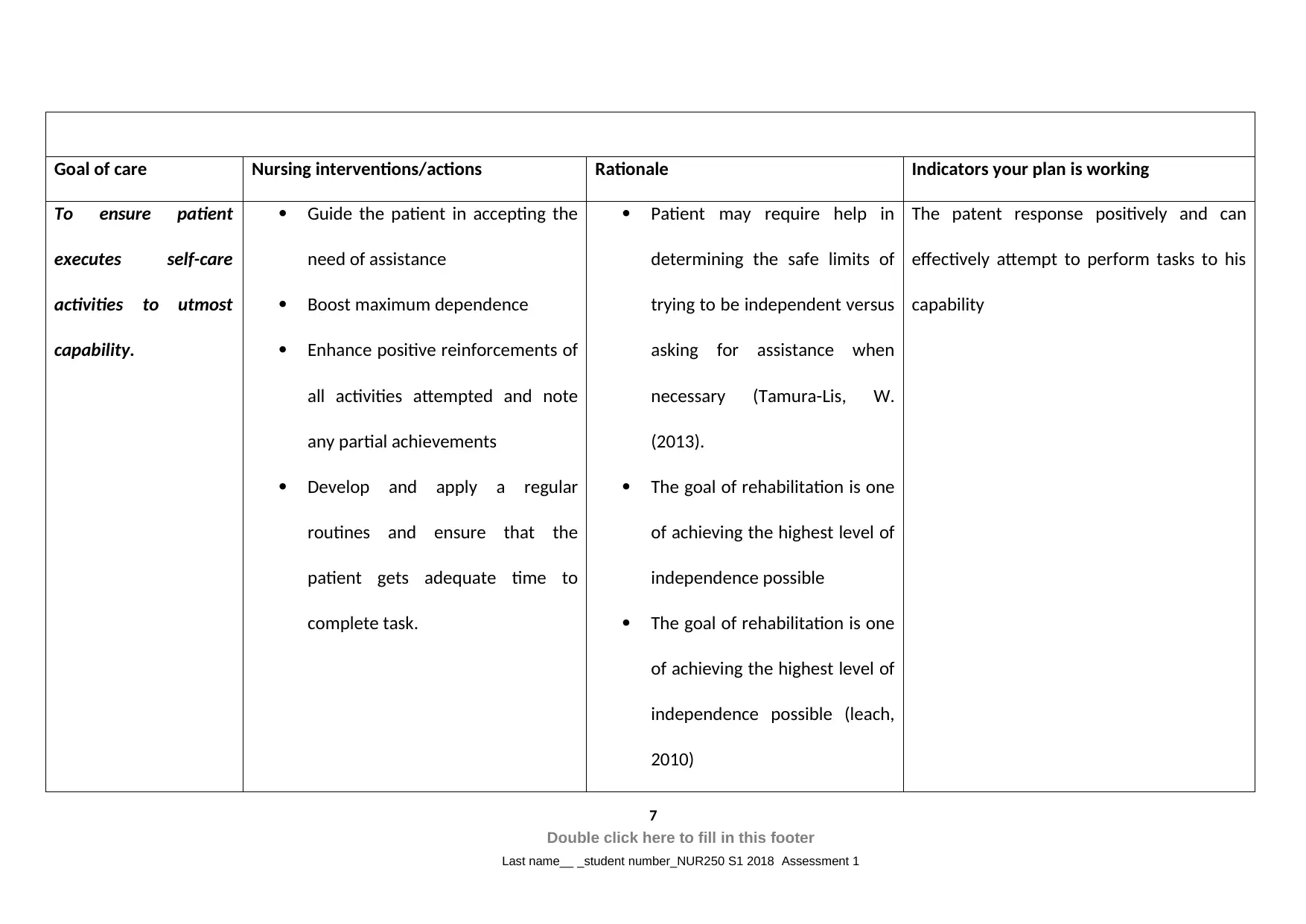
Goal of care Nursing interventions/actions Rationale Indicators your plan is working
To ensure patient
executes self-care
activities to utmost
capability.
Guide the patient in accepting the
need of assistance
Boost maximum dependence
Enhance positive reinforcements of
all activities attempted and note
any partial achievements
Develop and apply a regular
routines and ensure that the
patient gets adequate time to
complete task.
Patient may require help in
determining the safe limits of
trying to be independent versus
asking for assistance when
necessary (Tamura-Lis, W.
(2013).
The goal of rehabilitation is one
of achieving the highest level of
independence possible
The goal of rehabilitation is one
of achieving the highest level of
independence possible (leach,
2010)
The patent response positively and can
effectively attempt to perform tasks to his
capability
7
Double click here to fill in this footer
Last name__ _student number_NUR250 S1 2018 Assessment 1
To ensure patient
executes self-care
activities to utmost
capability.
Guide the patient in accepting the
need of assistance
Boost maximum dependence
Enhance positive reinforcements of
all activities attempted and note
any partial achievements
Develop and apply a regular
routines and ensure that the
patient gets adequate time to
complete task.
Patient may require help in
determining the safe limits of
trying to be independent versus
asking for assistance when
necessary (Tamura-Lis, W.
(2013).
The goal of rehabilitation is one
of achieving the highest level of
independence possible
The goal of rehabilitation is one
of achieving the highest level of
independence possible (leach,
2010)
The patent response positively and can
effectively attempt to perform tasks to his
capability
7
Double click here to fill in this footer
Last name__ _student number_NUR250 S1 2018 Assessment 1
Paraphrase This Document
Need a fresh take? Get an instant paraphrase of this document with our AI Paraphraser
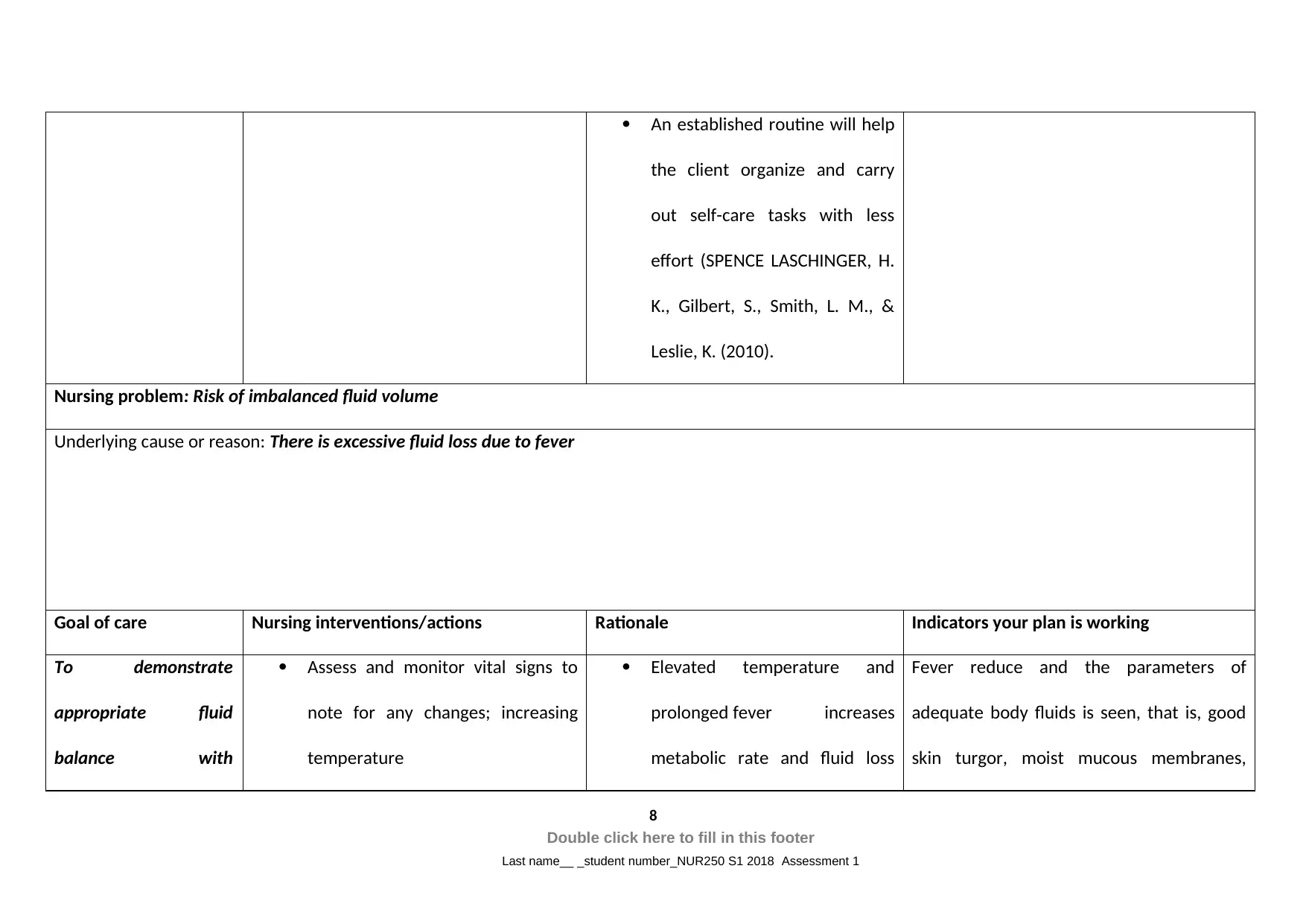
An established routine will help
the client organize and carry
out self-care tasks with less
effort (SPENCE LASCHINGER, H.
K., Gilbert, S., Smith, L. M., &
Leslie, K. (2010).
Nursing problem: Risk of imbalanced fluid volume
Underlying cause or reason: There is excessive fluid loss due to fever
Goal of care Nursing interventions/actions Rationale Indicators your plan is working
To demonstrate
appropriate fluid
balance with
Assess and monitor vital signs to
note for any changes; increasing
temperature
Elevated temperature and
prolonged fever increases
metabolic rate and fluid loss
Fever reduce and the parameters of
adequate body fluids is seen, that is, good
skin turgor, moist mucous membranes,
8
Double click here to fill in this footer
Last name__ _student number_NUR250 S1 2018 Assessment 1
the client organize and carry
out self-care tasks with less
effort (SPENCE LASCHINGER, H.
K., Gilbert, S., Smith, L. M., &
Leslie, K. (2010).
Nursing problem: Risk of imbalanced fluid volume
Underlying cause or reason: There is excessive fluid loss due to fever
Goal of care Nursing interventions/actions Rationale Indicators your plan is working
To demonstrate
appropriate fluid
balance with
Assess and monitor vital signs to
note for any changes; increasing
temperature
Elevated temperature and
prolonged fever increases
metabolic rate and fluid loss
Fever reduce and the parameters of
adequate body fluids is seen, that is, good
skin turgor, moist mucous membranes,
8
Double click here to fill in this footer
Last name__ _student number_NUR250 S1 2018 Assessment 1
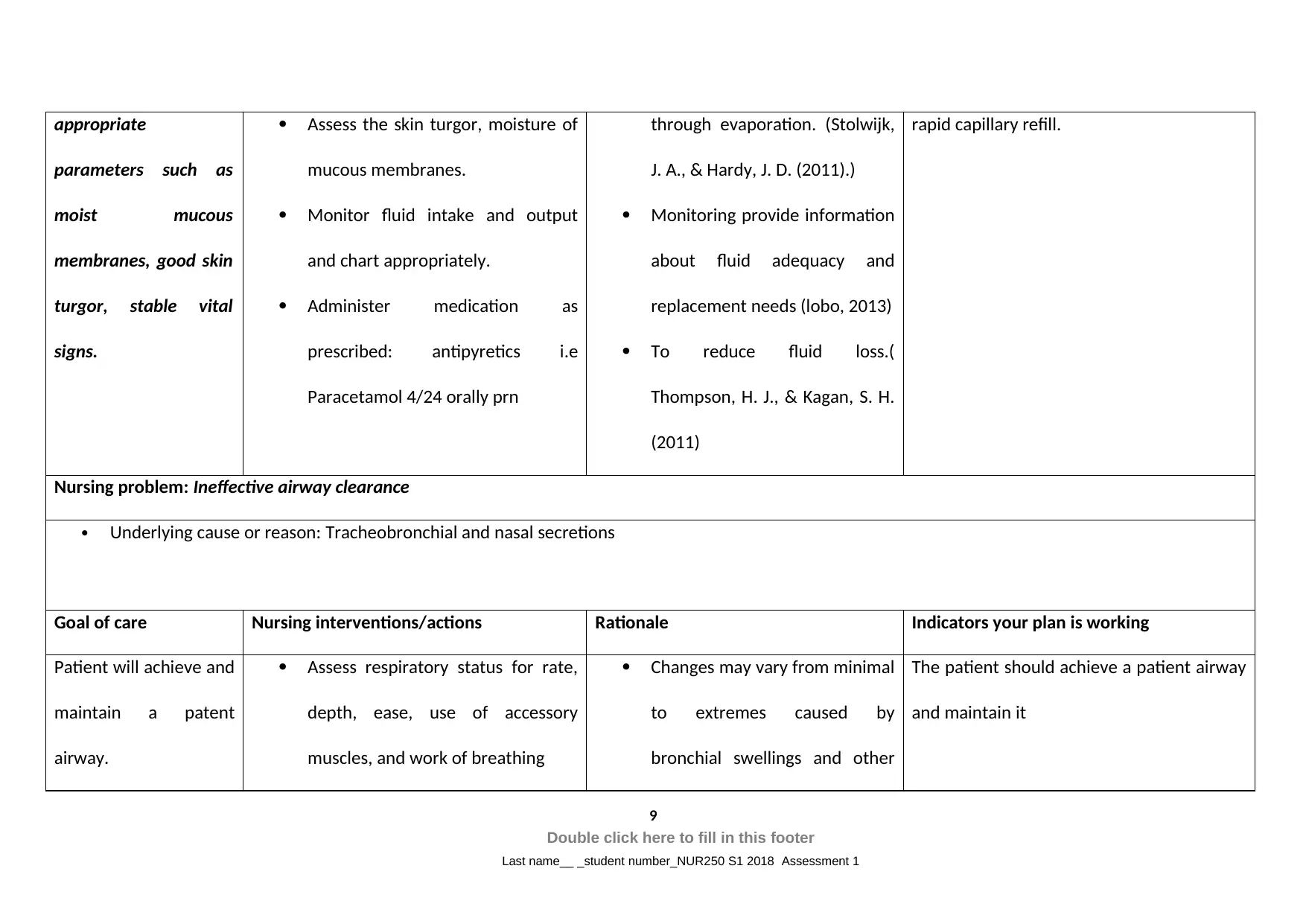
appropriate
parameters such as
moist mucous
membranes, good skin
turgor, stable vital
signs.
Assess the skin turgor, moisture of
mucous membranes.
Monitor fluid intake and output
and chart appropriately.
Administer medication as
prescribed: antipyretics i.e
Paracetamol 4/24 orally prn
through evaporation. (Stolwijk,
J. A., & Hardy, J. D. (2011).)
Monitoring provide information
about fluid adequacy and
replacement needs (lobo, 2013)
To reduce fluid loss.(
Thompson, H. J., & Kagan, S. H.
(2011)
rapid capillary refill.
Nursing problem: Ineffective airway clearance
Underlying cause or reason: Tracheobronchial and nasal secretions
Goal of care Nursing interventions/actions Rationale Indicators your plan is working
Patient will achieve and
maintain a patent
airway.
Assess respiratory status for rate,
depth, ease, use of accessory
muscles, and work of breathing
Changes may vary from minimal
to extremes caused by
bronchial swellings and other
The patient should achieve a patient airway
and maintain it
9
Double click here to fill in this footer
Last name__ _student number_NUR250 S1 2018 Assessment 1
parameters such as
moist mucous
membranes, good skin
turgor, stable vital
signs.
Assess the skin turgor, moisture of
mucous membranes.
Monitor fluid intake and output
and chart appropriately.
Administer medication as
prescribed: antipyretics i.e
Paracetamol 4/24 orally prn
through evaporation. (Stolwijk,
J. A., & Hardy, J. D. (2011).)
Monitoring provide information
about fluid adequacy and
replacement needs (lobo, 2013)
To reduce fluid loss.(
Thompson, H. J., & Kagan, S. H.
(2011)
rapid capillary refill.
Nursing problem: Ineffective airway clearance
Underlying cause or reason: Tracheobronchial and nasal secretions
Goal of care Nursing interventions/actions Rationale Indicators your plan is working
Patient will achieve and
maintain a patent
airway.
Assess respiratory status for rate,
depth, ease, use of accessory
muscles, and work of breathing
Changes may vary from minimal
to extremes caused by
bronchial swellings and other
The patient should achieve a patient airway
and maintain it
9
Double click here to fill in this footer
Last name__ _student number_NUR250 S1 2018 Assessment 1
⊘ This is a preview!⊘
Do you want full access?
Subscribe today to unlock all pages.

Trusted by 1+ million students worldwide
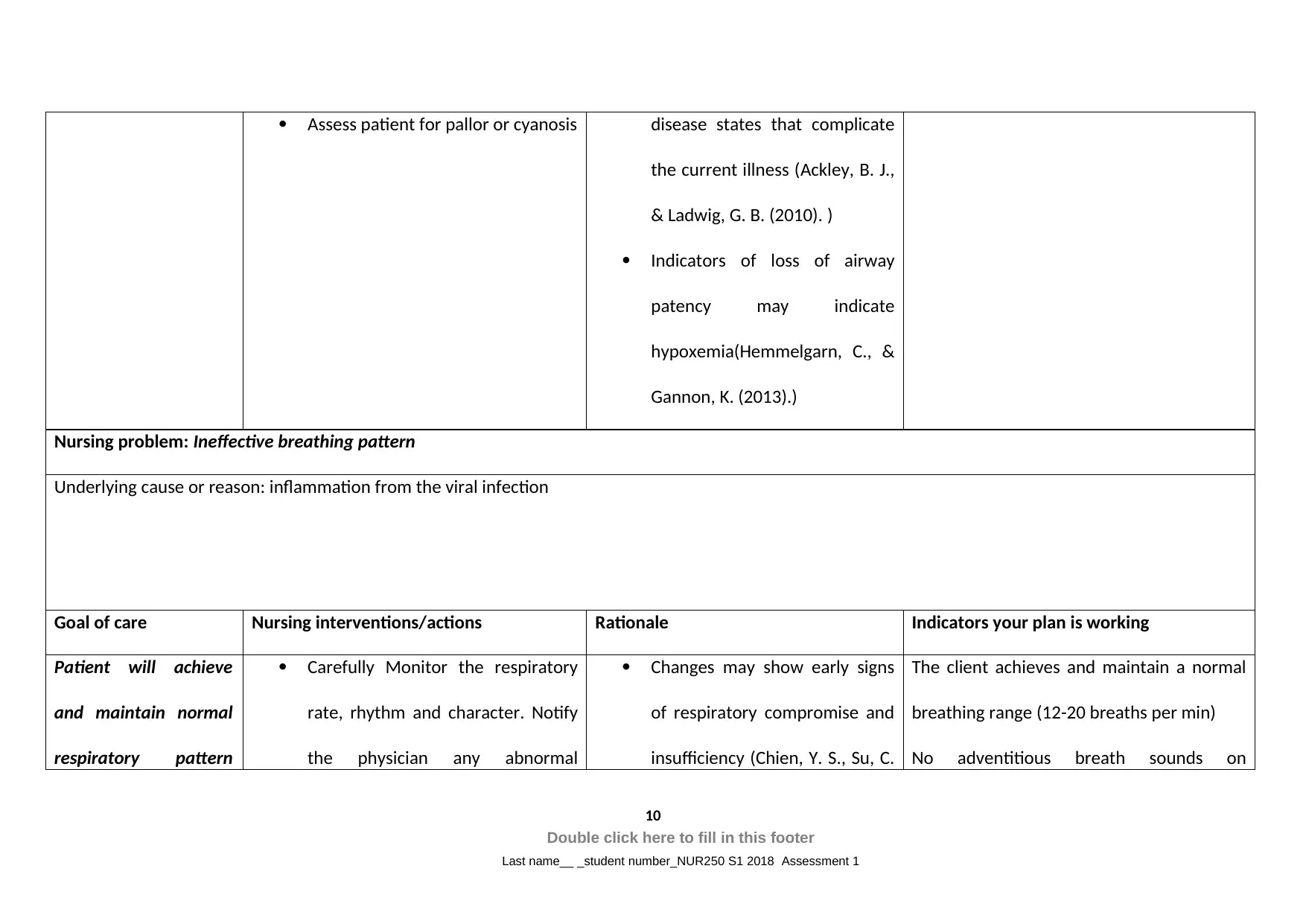
Assess patient for pallor or cyanosis disease states that complicate
the current illness (Ackley, B. J.,
& Ladwig, G. B. (2010). )
Indicators of loss of airway
patency may indicate
hypoxemia(Hemmelgarn, C., &
Gannon, K. (2013).)
Nursing problem: Ineffective breathing pattern
Underlying cause or reason: inflammation from the viral infection
Goal of care Nursing interventions/actions Rationale Indicators your plan is working
Patient will achieve
and maintain normal
respiratory pattern
Carefully Monitor the respiratory
rate, rhythm and character. Notify
the physician any abnormal
Changes may show early signs
of respiratory compromise and
insufficiency (Chien, Y. S., Su, C.
The client achieves and maintain a normal
breathing range (12-20 breaths per min)
No adventitious breath sounds on
10
Double click here to fill in this footer
Last name__ _student number_NUR250 S1 2018 Assessment 1
the current illness (Ackley, B. J.,
& Ladwig, G. B. (2010). )
Indicators of loss of airway
patency may indicate
hypoxemia(Hemmelgarn, C., &
Gannon, K. (2013).)
Nursing problem: Ineffective breathing pattern
Underlying cause or reason: inflammation from the viral infection
Goal of care Nursing interventions/actions Rationale Indicators your plan is working
Patient will achieve
and maintain normal
respiratory pattern
Carefully Monitor the respiratory
rate, rhythm and character. Notify
the physician any abnormal
Changes may show early signs
of respiratory compromise and
insufficiency (Chien, Y. S., Su, C.
The client achieves and maintain a normal
breathing range (12-20 breaths per min)
No adventitious breath sounds on
10
Double click here to fill in this footer
Last name__ _student number_NUR250 S1 2018 Assessment 1
Paraphrase This Document
Need a fresh take? Get an instant paraphrase of this document with our AI Paraphraser
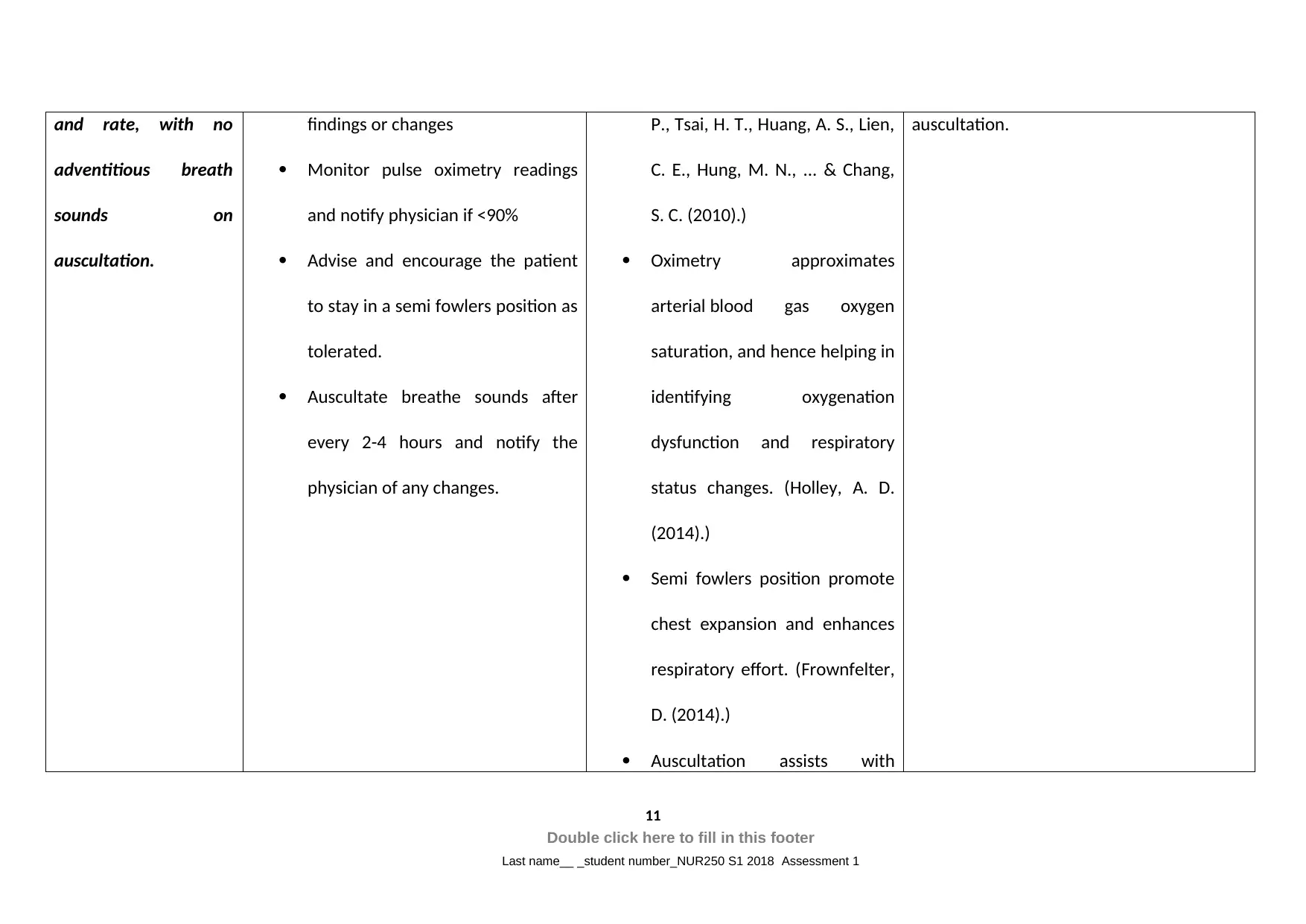
and rate, with no
adventitious breath
sounds on
auscultation.
findings or changes
Monitor pulse oximetry readings
and notify physician if <90%
Advise and encourage the patient
to stay in a semi fowlers position as
tolerated.
Auscultate breathe sounds after
every 2-4 hours and notify the
physician of any changes.
P., Tsai, H. T., Huang, A. S., Lien,
C. E., Hung, M. N., ... & Chang,
S. C. (2010).)
Oximetry approximates
arterial blood gas oxygen
saturation, and hence helping in
identifying oxygenation
dysfunction and respiratory
status changes. (Holley, A. D.
(2014).)
Semi fowlers position promote
chest expansion and enhances
respiratory effort. (Frownfelter,
D. (2014).)
Auscultation assists with
auscultation.
11
Double click here to fill in this footer
Last name__ _student number_NUR250 S1 2018 Assessment 1
adventitious breath
sounds on
auscultation.
findings or changes
Monitor pulse oximetry readings
and notify physician if <90%
Advise and encourage the patient
to stay in a semi fowlers position as
tolerated.
Auscultate breathe sounds after
every 2-4 hours and notify the
physician of any changes.
P., Tsai, H. T., Huang, A. S., Lien,
C. E., Hung, M. N., ... & Chang,
S. C. (2010).)
Oximetry approximates
arterial blood gas oxygen
saturation, and hence helping in
identifying oxygenation
dysfunction and respiratory
status changes. (Holley, A. D.
(2014).)
Semi fowlers position promote
chest expansion and enhances
respiratory effort. (Frownfelter,
D. (2014).)
Auscultation assists with
auscultation.
11
Double click here to fill in this footer
Last name__ _student number_NUR250 S1 2018 Assessment 1
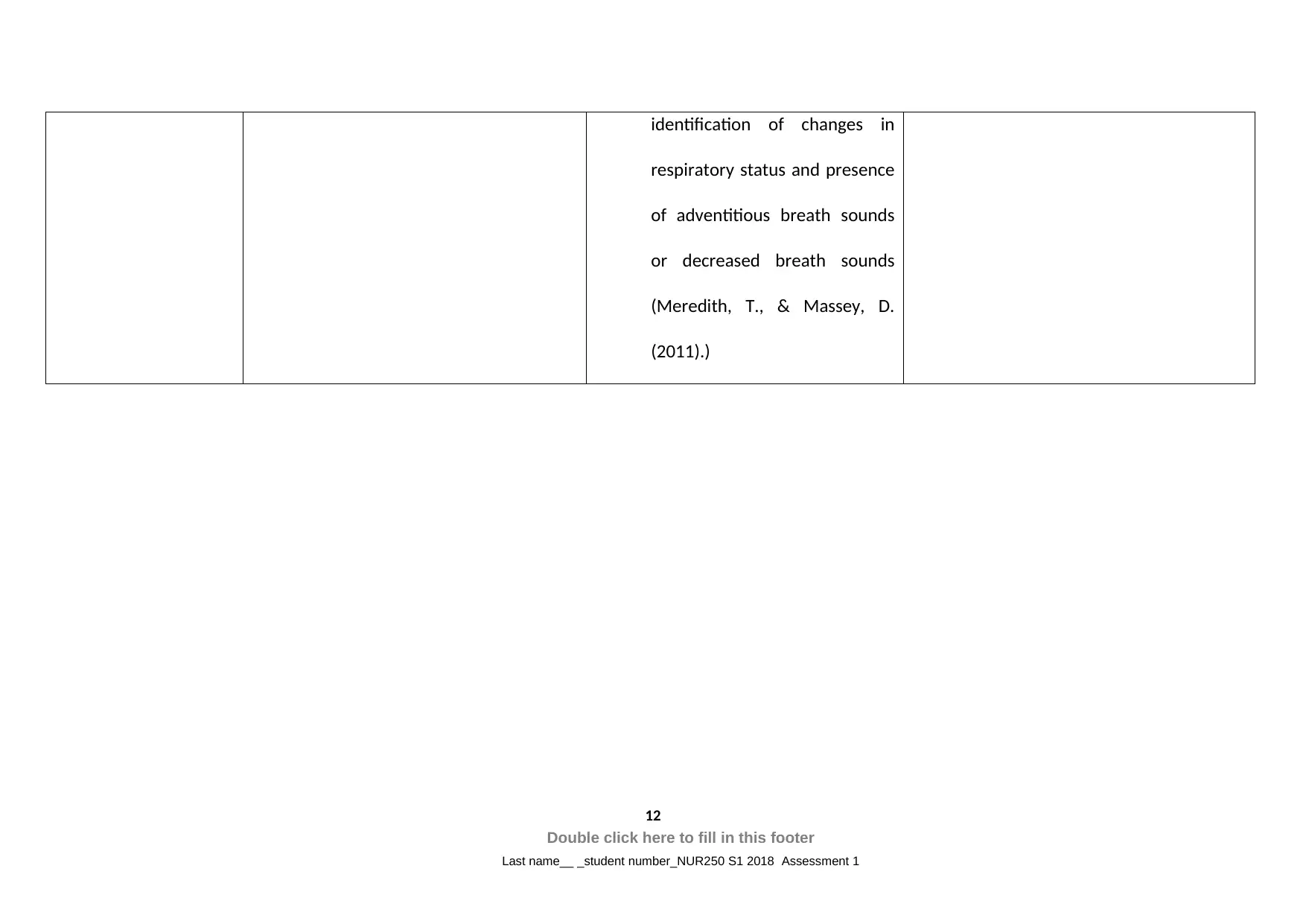
identification of changes in
respiratory status and presence
of adventitious breath sounds
or decreased breath sounds
(Meredith, T., & Massey, D.
(2011).)
12
Double click here to fill in this footer
Last name__ _student number_NUR250 S1 2018 Assessment 1
respiratory status and presence
of adventitious breath sounds
or decreased breath sounds
(Meredith, T., & Massey, D.
(2011).)
12
Double click here to fill in this footer
Last name__ _student number_NUR250 S1 2018 Assessment 1
⊘ This is a preview!⊘
Do you want full access?
Subscribe today to unlock all pages.

Trusted by 1+ million students worldwide
1 out of 18
Related Documents
Your All-in-One AI-Powered Toolkit for Academic Success.
+13062052269
info@desklib.com
Available 24*7 on WhatsApp / Email
![[object Object]](/_next/static/media/star-bottom.7253800d.svg)
Unlock your academic potential
Copyright © 2020–2025 A2Z Services. All Rights Reserved. Developed and managed by ZUCOL.


